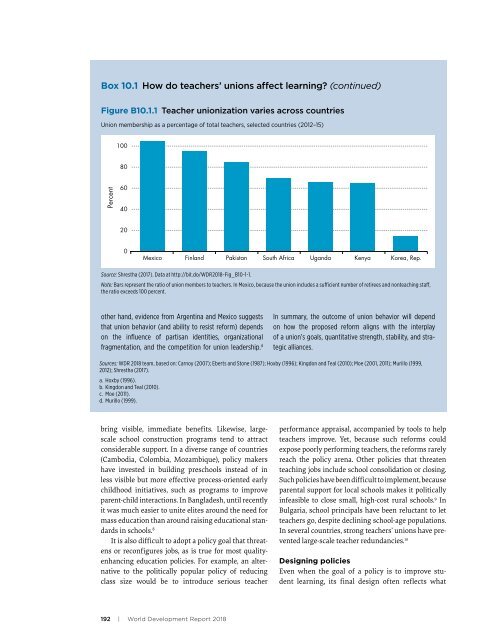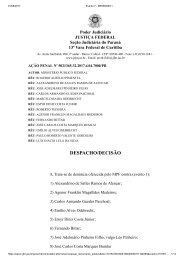Brasil só deve dominar Leitura em 260 anos, aponta estudo do Banco Mundial Relatorio Banco Mundial _Learning
You also want an ePaper? Increase the reach of your titles
YUMPU automatically turns print PDFs into web optimized ePapers that Google loves.
Box 10.1 How <strong>do</strong> teachers’ unions affect learning? (continued)<br />
Figure B10.1.1 Teacher unionization varies across countries<br />
Union m<strong>em</strong>bership as a percentage of total teachers, selected countries (2012–15)<br />
100<br />
80<br />
Percent<br />
60<br />
40<br />
20<br />
0<br />
Mexico Finland Pakistan South Africa Uganda Kenya Korea, Rep.<br />
Source: Shrestha (2017). Data at http://bit.<strong>do</strong>/WDR2018-Fig_B10-1-1.<br />
Note: Bars represent the ratio of union m<strong>em</strong>bers to teachers. In Mexico, because the union includes a sufficient number of retirees and nonteaching staff,<br />
the ratio exceeds 100 percent.<br />
other hand, evidence from Argentina and Mexico suggests<br />
that union behavior (and ability to resist reform) depends<br />
on the influence of partisan identities, organizational<br />
fragmentation, and the competition for union leadership. d<br />
In summary, the outcome of union behavior will depend<br />
on how the proposed reform aligns with the interplay<br />
of a union’s goals, quantitative strength, stability, and strategic<br />
alliances.<br />
Sources: WDR 2018 team, based on: Carnoy (2007); Eberts and Stone (1987); Hoxby (1996); King<strong>do</strong>n and Teal (2010); Moe (2001, 2011); Murillo (1999,<br />
2012); Shrestha (2017).<br />
a. Hoxby (1996).<br />
b. King<strong>do</strong>n and Teal (2010).<br />
c. Moe (2011).<br />
d. Murillo (1999).<br />
bring visible, immediate benefits. Likewise, largescale<br />
school construction programs tend to attract<br />
considerable support. In a diverse range of countries<br />
(Cambodia, Colombia, Mozambique), policy makers<br />
have invested in building preschools instead of in<br />
less visible but more effective process-oriented early<br />
childhood initiatives, such as programs to improve<br />
parent-child interactions. In Bangladesh, until recently<br />
it was much easier to unite elites around the need for<br />
mass education than around raising educational standards<br />
in schools. 8<br />
It is also difficult to a<strong>do</strong>pt a policy goal that threatens<br />
or reconfigures jobs, as is true for most qualityenhancing<br />
education policies. For example, an alternative<br />
to the politically popular policy of reducing<br />
class size would be to introduce serious teacher<br />
performance appraisal, accompanied by tools to help<br />
teachers improve. Yet, because such reforms could<br />
expose poorly performing teachers, the reforms rarely<br />
reach the policy arena. Other policies that threaten<br />
teaching jobs include school consolidation or closing.<br />
Such policies have been difficult to impl<strong>em</strong>ent, because<br />
parental support for local schools makes it politically<br />
infeasible to close small, high-cost rural schools. 9 In<br />
Bulgaria, school principals have been reluctant to let<br />
teachers go, despite declining school-age populations.<br />
In several countries, strong teachers’ unions have prevented<br />
large-scale teacher redundancies. 10<br />
Designing policies<br />
Even when the goal of a policy is to improve student<br />
learning, its final design often reflects what<br />
192 | World Development Report 2018








